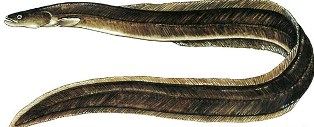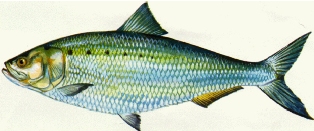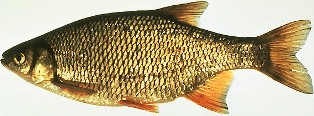Discover Florida Nature
It's time to explore the natural Florida


|
|
|
|
|
This is a group of miscellaneous freshwater fish found in Florida. The
group contains the American Eel, American Shad, Atlantic Sturgeon,
Bowfin, Golden Shiner, Mosquito Fish, Shortnose Sturgeon, Skipjack
Herring, Kuhli, Mozambique Tilapia, and Pacu. These freshwater fish do
not fit into any of our other categories so we have grouped them
together in these two pages. American
Eel
(Anguilla rostrata) The body of the American eel, or
the common eel as it is also called, is extremely elongated (snakelike),
with a very long dorsal fin that is confluent with the anal fin. Pelvic
fins are absent and tiny scales are embedded in the skin giving eels a
smooth feel. The adult color is a yellow-brown with a pale underbelly.
Eels primarily reside in rivers but sometimes access ponds and lakes.
They orient to structure and flow. Common eels are predators that feed
on insects, crustaceans, mollusks and some fish. Although often
associated with decaying food, they prefer live food. American eels are
known to live as long as 43 years, but generally migrate to spawn and
die long before then. This is a gourmet fish in the Asian markets and is
often used in Sushi. It tends to be bony by American standards but is
good smoked. American
Eel
(Anguilla rostrata) The body of the American eel, or
the common eel as it is also called, is extremely elongated (snakelike),
with a very long dorsal fin that is confluent with the anal fin. Pelvic
fins are absent and tiny scales are embedded in the skin giving eels a
smooth feel. The adult color is a yellow-brown with a pale underbelly.
Eels primarily reside in rivers but sometimes access ponds and lakes.
They orient to structure and flow. Common eels are predators that feed
on insects, crustaceans, mollusks and some fish. Although often
associated with decaying food, they prefer live food. American eels are
known to live as long as 43 years, but generally migrate to spawn and
die long before then. This is a gourmet fish in the Asian markets and is
often used in Sushi. It tends to be bony by American standards but is
good smoked. American
Shad
(Alosa sapidissima) Green or greenish blue with metallic luster
on back, the American shad has silvery sides. The body is compressed and
the lower jaw does not protrude beyond upper jaw Teeth are often
missing in American shad that are greater than 8 inches. Sometimes the
American shad will have a few spots on it's sides behind shoulder spot.
In Florida, the American shad occurs only in the northeast, mostly in
the St. Johns River and Nassau River. Most spawning occurs between late
December and early April in the stretch of the St. Johns River from
Sanford to Melbourne. Eggs are spawned directly into the river where
they drift freely for 2-3 days. Juveniles leave the river when it cools
in late fall or early winter. Juveniles mature into adults in the
Atlantic Ocean and do not return to the St. Johns River until they are
ready to spawn, two to five years later. In the St. Johns River and all
other rivers below Cape Fear, North Carolina, shad die after they spawn.
American shad are plankton feeders, but strikes small bright spoons and
flies American
Shad
(Alosa sapidissima) Green or greenish blue with metallic luster
on back, the American shad has silvery sides. The body is compressed and
the lower jaw does not protrude beyond upper jaw Teeth are often
missing in American shad that are greater than 8 inches. Sometimes the
American shad will have a few spots on it's sides behind shoulder spot.
In Florida, the American shad occurs only in the northeast, mostly in
the St. Johns River and Nassau River. Most spawning occurs between late
December and early April in the stretch of the St. Johns River from
Sanford to Melbourne. Eggs are spawned directly into the river where
they drift freely for 2-3 days. Juveniles leave the river when it cools
in late fall or early winter. Juveniles mature into adults in the
Atlantic Ocean and do not return to the St. Johns River until they are
ready to spawn, two to five years later. In the St. Johns River and all
other rivers below Cape Fear, North Carolina, shad die after they spawn.
American shad are plankton feeders, but strikes small bright spoons and
flies Atlantic
Sturgeon (Acipenser oxyrinchus oxyrinchus) Sturgeon in
general are easily recognizable by the bony plates on their bodies and
barbels (whiskers) on their chin. Sturgeon are among the oldest living
species of fish and retain many primitive characteristics typical of
fish during the age of the dinosaurs. Almost two dozen species of
sturgeon can be found in the Northern Hemisphere, of which seven occur
in North America. The Gulf sturgeon (a subspecies of Atlantic sturgeon)
have a V-shaped snout with two pairs of barbels and two rows of plates
in front of the vent. The back is typically blue black with a white or
cream colored belly. Atlantic sturgeon are found primarily in shallow
offshore waters but come in to the rivers to spawn. Bottom feeders, the
Atlantic stugeon consumes primarily mollusks and other sedentary bottom
dwelling organisms. Atlantic sturgeon have been known to reach 14 feet
in length, weigh over 800 pounds and live for at least 60 years. Atlantic
Sturgeon (Acipenser oxyrinchus oxyrinchus) Sturgeon in
general are easily recognizable by the bony plates on their bodies and
barbels (whiskers) on their chin. Sturgeon are among the oldest living
species of fish and retain many primitive characteristics typical of
fish during the age of the dinosaurs. Almost two dozen species of
sturgeon can be found in the Northern Hemisphere, of which seven occur
in North America. The Gulf sturgeon (a subspecies of Atlantic sturgeon)
have a V-shaped snout with two pairs of barbels and two rows of plates
in front of the vent. The back is typically blue black with a white or
cream colored belly. Atlantic sturgeon are found primarily in shallow
offshore waters but come in to the rivers to spawn. Bottom feeders, the
Atlantic stugeon consumes primarily mollusks and other sedentary bottom
dwelling organisms. Atlantic sturgeon have been known to reach 14 feet
in length, weigh over 800 pounds and live for at least 60 years. Bowfin
(Amia calva) The bowfin is the only living representative of an
ancient family of fishes. It has an air-bladder which functions somewhat
like a lung, and they are often seen near the surface of the water
gulping mouthfuls of air. They are easily recognized by its flattened
head; long, stout body; large mouth full of small, sharp teeth; long
dorsal fin that extends along most of the back; and rounded tail. The
pelvic fins are set far back on the belly near the middle of the body
and the pectoral fins are low on the sides so that the overall
appearance is one of three sets of fins in a row; the pectorals behind
the head, the pelvics near the midbody, and the anal fin near the tail.
Also, two short tube-like barbels are located near the nostrils. The
body is olive-green above, shading to pale yellow or cream on the belly.
Several dark brown, horizontal bars are often evident on the cheeks.
Males have a dark spot with a bright orange halo, on the upper part of
the tail fin. The spot is absent or inconspicuous on females. Found
throughout Florida, the bowfin prefers swamps, and the backwaters of
lowland streams. Usually found near vegetation, the bowfin live in warm,
poorly oxygenated waters that are uninhabitable to most fishes. About 80
percent of their diet consists of fish, with crayfish being the second
most dominant food item. They stalk their prey using their senses of
smell and sight. Growth is very rapid. Bowfin may grow to over three
feet long and weigh over 15 pounds. Bowfin
(Amia calva) The bowfin is the only living representative of an
ancient family of fishes. It has an air-bladder which functions somewhat
like a lung, and they are often seen near the surface of the water
gulping mouthfuls of air. They are easily recognized by its flattened
head; long, stout body; large mouth full of small, sharp teeth; long
dorsal fin that extends along most of the back; and rounded tail. The
pelvic fins are set far back on the belly near the middle of the body
and the pectoral fins are low on the sides so that the overall
appearance is one of three sets of fins in a row; the pectorals behind
the head, the pelvics near the midbody, and the anal fin near the tail.
Also, two short tube-like barbels are located near the nostrils. The
body is olive-green above, shading to pale yellow or cream on the belly.
Several dark brown, horizontal bars are often evident on the cheeks.
Males have a dark spot with a bright orange halo, on the upper part of
the tail fin. The spot is absent or inconspicuous on females. Found
throughout Florida, the bowfin prefers swamps, and the backwaters of
lowland streams. Usually found near vegetation, the bowfin live in warm,
poorly oxygenated waters that are uninhabitable to most fishes. About 80
percent of their diet consists of fish, with crayfish being the second
most dominant food item. They stalk their prey using their senses of
smell and sight. Growth is very rapid. Bowfin may grow to over three
feet long and weigh over 15 pounds.  Golden
Shiner (Fundulus jenkinsi) A golden hue with reddish fins is
typical of the golden shiner, it has a small soft-rayed dorsal fin and
like other shiners has a lateral line (the series of sensory holes along
the side of a fish) that dips downward. Widely distributed along the
east coast of North America from Canada south and throughout Florida and
as far west as the Dakotas, the golden shiner is often found in
vegetated ponds and lakes, and sometimes found in slack waters of
rivers. Shiners consume small insects, tiny mollusks, small fishes and
perhaps algae. They live up to about 5 years and reach a maximum size of
nearly one foot. Golden
Shiner (Fundulus jenkinsi) A golden hue with reddish fins is
typical of the golden shiner, it has a small soft-rayed dorsal fin and
like other shiners has a lateral line (the series of sensory holes along
the side of a fish) that dips downward. Widely distributed along the
east coast of North America from Canada south and throughout Florida and
as far west as the Dakotas, the golden shiner is often found in
vegetated ponds and lakes, and sometimes found in slack waters of
rivers. Shiners consume small insects, tiny mollusks, small fishes and
perhaps algae. They live up to about 5 years and reach a maximum size of
nearly one foot.
|
|
|
Advertise | Privacy Statement | Dog Encyclopedia | Video |Contact | Alaska Nature |
|